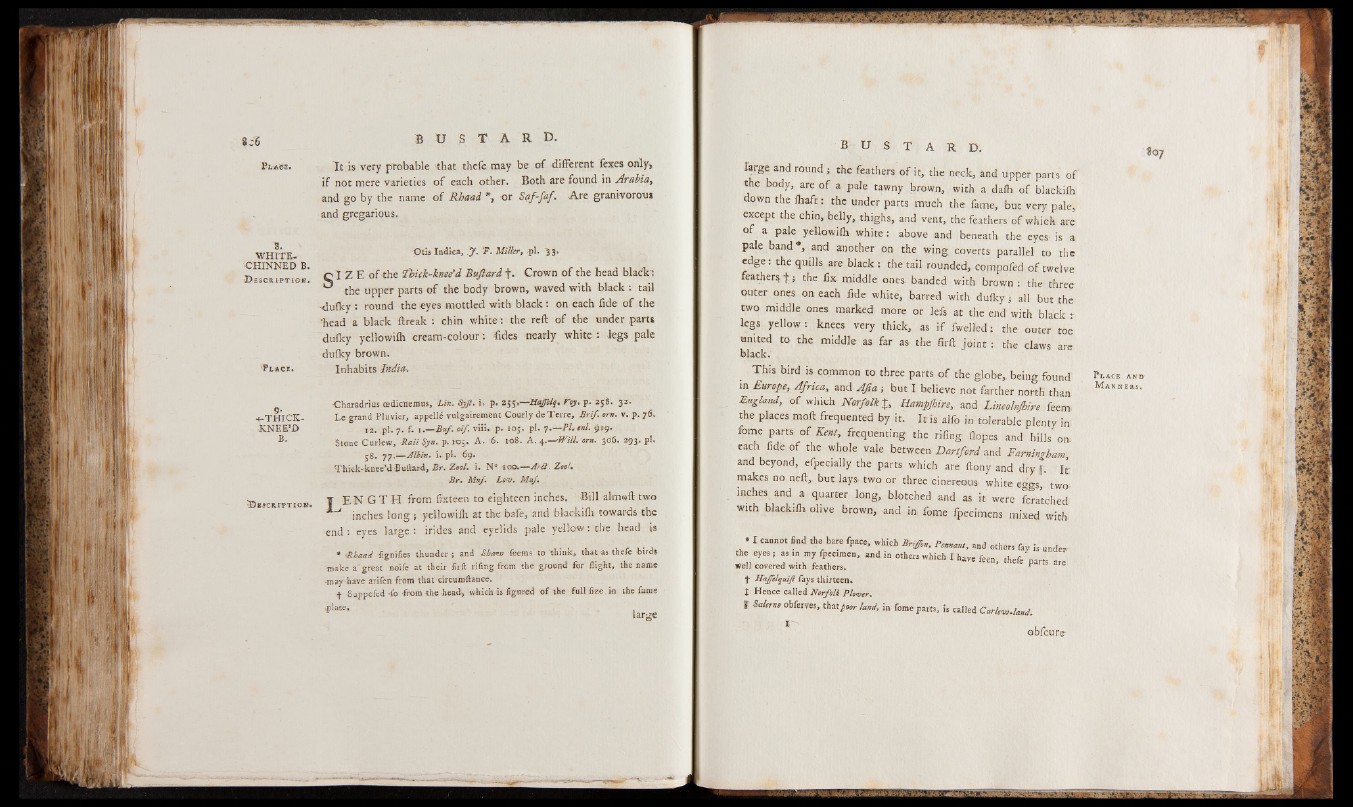
8-'6 B U S T A R D.
P-I.ACS.
s.
WHITE-
CHINNED B.
' D e s c r i p t i o n .
P l a c e .
9-
•i-THICK-
■ KNEEfD
B.
‘DrSCRITTION.
It is very probable that thefe may be of different fexes only,
if not mere varieties of each other. Both are found in Arabia,
and go by the name of Rhaad *, or Saf-faf. Are granivorou*
and gregarious.
Otis Indies, y . F . Miller, pi- 35*
Q l z E of the Tbick-knee’d Buftard f . Crown of the head blade
the upper parts of the body brown, waved with black - tail
■ dulky : round the eyes mottled with black: on each fide of the
■ head a black ftreak : chin white: the reft of the under parts
dulky yellowilh cream-colour: tides nearly white : legs pale
dulky brown.
Inhabits India.
-Charadrius cedicttemus, Lin. Syji. i. p. 25$-.—Raffelq. Voy. p. 258. 32■
Le grand Pluvier, appelle vulgairement Courly de Terre, Brif. era. v. p. 76.
12. pi. 7. f. 1.— Buf. oif. »fit. p. !Qj. pi- 7.—Pl.enl. $19.
Stone Curlew, Rent $yn. p. 105. A, 6. 108. A. 4.-^Will.ern. 306. 293. pl>
38. 77.— Albin. i. pi. 69.
Thick-knee’d-Bullard, Br. Zool. i. N° -ioo.— Aril. Zrnl.
Br. Muf Leu. Muf.
•N G T H from lixteen to eighteen inches, Bill airmail two
inches lo n g ; yellowilh at the bafe, and blackilh Cowards the
•end : eyes large : irides and eyelids pale yellow: the head is
* Rhaad dignifies thunder-; and Sbanu deems to 'think, tha-t as thefe birds
make a" great noife at their firft riling from the ground for flight, the name
may have arifen from that circumftance.
4 Suppofed >fo -from-the-head, which is figured of the full fi-ze .in the fame
b u s t a r d . 8o;
Targe and round; the feathers of it, the neck, and upper parts o f
the body, are of a pale tawny brown, with a dafh of blackilh
down the lhaft: the under parts much the fame, but very pale,
except the chin, belly, thighs, and vent, the feathers of which are
of a pale yellowilh white : above and beneath the eyes is a
pale band*, and another on the wing coverts parallel to the
edge: the quills are black : the tail rounded, compofed of twelve
feathery -j-; the fix middle ones banded with brown : the three
outer ones on each fide white, barred with dulky; all but the
two middle ones marked more or lefs at the end with black :
legs yellow: knees very thick, as if fwelled: the outer toe
united to the middle as far as the firft joint : the claws are
black.
This bird is cornmon to three parts of the globe,, being found' Pcace and
in Europe, Africa, and Afia, ; but I believe not farther north than Ma" nees-
England, of which Norfolk J, Uampfhire, and Lincolnjhire feem-
the places moll frequented by it. It is alfo in tolerable plenty f„
feme parts of Kent, frequenting the riling (lopes and hills on:
each fide of the whole vale between Hartford and Farningham
and beyond, efpecially the parts which are (tony and dry ||; It
makes tro neft, but lays- two or three cinereous- white eggs, two-
inches and a quarter long, blotched and as it were Scratched
with blackilh olive brown, and in fome ipecimens mixed with-
. - • w * ” ‘nuni> dnu otners lay. is underthe
eyes; as g my fpec.men, and in others which I have fen-,. thefe parts are
Well covered with feathers* v e
f HaJJelquiJi fays thirteen.
t Hence called Norfolk Plover.
U Salem obferves, that/sor land, in fome parts, is called Curlew-land.
obfeure